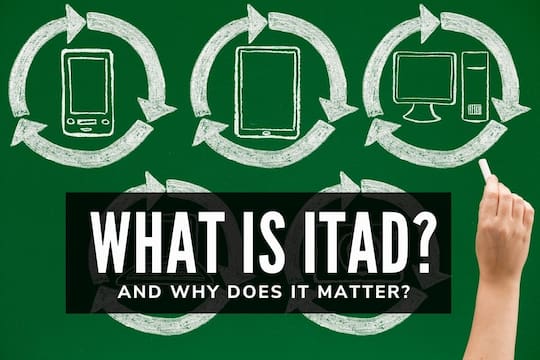
Overlooking IT Asset Disposition (ITAD) can lead to significant risks for organizations regarding data security and environmental impact. Unfortunately, in today’s rapidly advancing technological landscape, organizations often neglect the essence of proper disposal of outdated IT assets.
ITAD encompasses the systematic management of retiring IT assets. This process ensures professionals securely and responsibly dispose of assets at the end of their lifecycle.
In this practical guide, we will delve into the intricacies of ITAD. We also emphasize its pivotal role in safeguarding sensitive data and promoting environmental sustainability.
What Is IT Asset Disposition?
It refers to the strategic management of retiring or decommissioning IT assets at the end of their lifecycle. This process involves the secure disposal, recycling, or remarketing of outdated equipment such as computers, servers, networking devices, and peripherals.
ITAD aims to maximize the value of retired assets while minimizing risks associated with data security breaches and regulatory non-compliance.
Essential components of ITAD include asset identification, data sanitization or destruction, and environmentally friendly disposal methods.
The Importance of Secure IT Asset Disposition
Failing to securely and responsibly manage the disposal of outdated IT assets can pose significant risks to organizations. Data breaches, regulatory non-compliance, and environmental harm are just some consequences of neglecting proper disposition practices.
By implementing ITAD protocols, organizations can mitigate these risks and protect critical information from falling into the wrong hands. Moreover, adequate disposition ensures compliance with data protection regulations, safeguarding organizations against costly penalties and reputational damage.
Best Practices of Secure IT Asset Disposition Services
Data security is paramount in ITAD initiatives to safeguard sensitive information throughout the disposal process. Implementing best practices ensures that data is securely handled and disposed of, mitigating the data breach risks and regulatory non-compliance.
Here are essential best practices for data security in ITAD:
- Thorough Data Sanitization: Utilize certified data-wiping software or hardware to overwrite data on storage devices and ensure that information is irretrievable. It also helps to employ physical destruction techniques such as shredding or degaussing for other media.
- Compliance with Regulations: IT asset disposition companies adhere to data protection regulations such as GDPR, HIPAA, and PCI DSS to ensure legal compliance. They also maintain documentation of data destruction processes and provide certificates of data sanitization to demonstrate compliance.
- Asset Tracking and Chain of Custody: They also Implement robust asset tracking systems to monitor the movement of IT assets throughout the disposal process. Professionals maintain a chain of custody, documenting everyone who handles the assets from collection to final disposition.
- Encryption: IT asset disposition providers encrypt data on storage devices before disposal to render it unreadable without the encryption key. They also ensure that encryption keys are securely managed and destroyed by best practices.
- Secure Transportation and Storage: They use secure transportation methods and containers to prevent unauthorized access during asset transfer. Experts store retired assets in a secure facility with limited access to reduce the risk of theft or tampering.
- Partnering with Certified ITAD Providers: They collaborate with reputable ITAD providers with certifications such as R2, e-Stewards, or ISO 14001. This secure IT asset disposition initiative ensures adherence to industry standards and regulations.
- Team Member Training and Awareness: For organizations, they can provide comprehensive training to employees involved in the ITAD process. In this training session, they must discuss the importance of data security protocols. Fostering a culture of awareness and accountability with data handling and disposal practices is also essential.
The ITAD Process Explained
The ITAD process encompasses steps aimed at securely and responsibly managing the disposal of outdated IT assets. Hence, understanding the intricacies of the process is crucial for organizations seeking to mitigate risks and promote sustainability.
Here are the steps that IT asset disposition companies follow:
- Identifying Assets for Disposition: Inventory management and asset tracking facilitate the identification of assets due for disposal. This step ensures every piece of equipment is noticed and accounted for.
- Data Sanitization and Destruction: Thorough data sanitization or destruction methods render sensitive information irretrievable, safeguarding against data breaches. So, service providers use certified data wiping software, physical destruction techniques, or data shredding to ensure data security compliance.
- Options for Reuse, Resale, or Recycling: IT asset disposition providers identify retired IT assets deemed suitable for reuse. Those beyond repair are recycled, with materials recovered and reused in new products, reducing environmental impact.
- Documentation and Reporting Procedures: Professionals create detailed documentation of the ITAD process, including asset disposition records and certificates of data destruction. They also include environmental compliance reports to ensure transparency, efficiency, and accountability.
Championing Sustainable Data Destruction
As technology evolves, data destruction becomes vital. Data-Destruction offers comprehensive IT asset disposition services to ensure the proper and environmentally responsible disposal of outdated assets.
By partnering with us, organizations can navigate the complexities of data destruction, knowing that their assets are in safe hands. So, embrace the future of IT asset management and join us in championing a safer, more sustainable digital world.